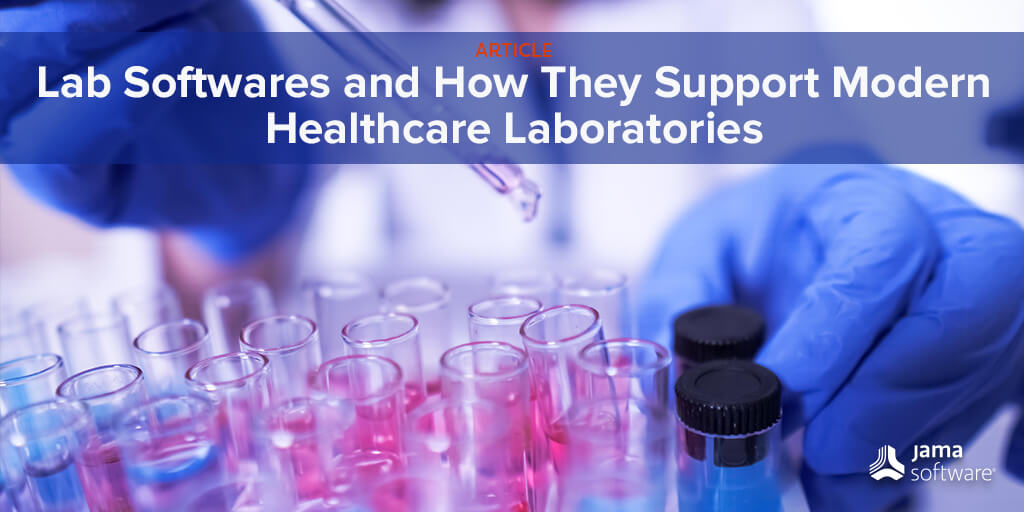
Lab Softwares and How They Support Modern Healthcare Laboratories
Modern healthcare laboratories look to information system software, also known as lab software, to support the management of lab-related patient data and maintain the complex and regulatory nature of lab testing.
Information systems designed for laboratories play an important role in meeting quality control standards by decreasing errors, incorporating automation, improving workflows, and more. Technological advances in laboratory instrumentation have resulted in a greater demand for (and reliance on) laboratory data to support clinical, microbiology, and public health needs.
In this blog post, we will define the differences between different information and management systems.
What is a LAS: Lab Automated System?
A Laboratory Automation System (LAS) is an integration of process control software and automation hardware, according to Sage Journals. LAS tends to appear in high throughput environments such as core labs, reference labs, or big testing labs such as LabCorp/Quest Diagnostics and is used to address high demands from basic to more advanced testing.
In larger labs, the same sample will be subjected to various instrumentations for different types of tests. This helps streamline test activities, reduce human error, and increase throughput. Through this method, some labs can generate 1000’s of test results per hour.
The notion of laboratory automation has existed for years, mostly in industrial and nonclinical environments, with plans to implement automation systems in clinical laboratories.
According to the National Center for Biotechnology, laboratory automation system “consists of robots, conveyor systems, machine vision, and computer hardware and software. Specimen movement and result reporting are based on identifying specimens using bar-coded specimens and bar-coded specimen carriers,” also known as pucks. Implementing a laboratory automation system depends on the presence of a laboratory information system information system.
RELATED: Understanding FDA Medical Device Class and Classifications, and its Impact on Requirements Management
What is a LIS: Lab Information System?
A Laboratory Information System (LIS), sometimes referred to as a laboratory information system or laboratory management system, is computer software that supports modern laboratory operations by processing, storing, and managing medical data. A LIS can also be categorized as a Medical Device Data System (MDDS), for which FDA regulations apply.
LIS is used by physicians and lab technicians to manage and coordinate patients’ medical data. According to TechTarget, “basic laboratory information systems commonly have features that manage patient check in, order entry, specimen processing, result entry and patient demographics. An LIS tracks and stores clinical details about a patient during a lab visit and keeps the information stored in its database for future reference.”
What are LIMS: Lab Information Management Systems (LIMS) and how does it compare to LIS?
LIS technology is closely related to laboratory information management system (LIMS). However, there are differences between the two software types.
A LIS is a healthcare system that holds clinical data. By comparison, LIMS can be deployed in “healthcare but it is also used in non-medical settings, including in environmental testing laboratories, pharmaceutical laboratories and water treatment plants” plus academia research and exploratory work.
LIMS stores and manages captured data, as well as producing reports from that data. The data capture process of a LIMS or LIS can reduce the time and error associated with the manual transcribing process.
What regulations do lab softwares follow?
Maintenance of laboratory information systems took on added importance with the introduction of the meaningful use program. The Centers for Medicare & Medicaid Services monitor the meaningful use program and consists of sets of criteria split into stage 1, stage 2, and stage 3.
Participating healthcare providers that successfully prove their electronic health record (EHR) systems or EHR modules – such as a LIS – satisfy program criteria and are eligible for incentive payments.
It is defined as an EHR module if a LIS is tested and certified to meet meaningful use criteria or other health IT certification standards.
“Some meaningful use reporting measures that could involve a LIS include the electronic submission of lab test results to public health agencies and the incorporation of clinical lab test results into a certified EHR system,” – TechTarget.
RELATED: Understanding FDA Medical Device Class and Classifications, and its Impact on Requirements Management
How Can Jama Connect Help?
As mentioned above, software plays an integral role in maintaining innovative laboratory processes. Whether it’s the software that drives the LAS track system, data storage and retrieval for LIMs, or maintaining the sample identification chain of custody in LIS, developing safe and effective software is essential to provide value to the lab and patients. Lab software manages complicated and logistical issues with patient data at risk, therefore documenting and managing the software requirements is ever more important. Whether required by regulations or not, maintaining a set of requirements is good business practice. The requirements provide the foundation for defining what the software can and cannot do for the lab.
Since many of these products are global, a common requirement that is needed, but generally overlooked or addressed late is localization and internationalization of the software. It is much harder and more expensive to add these software capabilities post launch, so maintain a good set of requirements for highlight these needs and provide visibility to the development team.
Furthermore, testing of these software requirements confirms that the right software was developed to fulfill its intended use, purpose, or goal. As with most products, change is evitable as the environment may change (new regulations), software bugs are found, or new features are added as the product evolves.
Jama Connect can also support understanding the impact change has on these software requirements, and its related activities.
To learn more about how Jama Software helps medical device companies, download our solution overview: Jama Connect Medical Device Solution Overview
- 2023 Predictions for Medical Device Product Development - December 22, 2022
- 2023 Predictions for Industrial and Consumer Electronics Product Development - December 15, 2022
- Euro Roundup: MDCG Publishes Guidance on MDR, IVDR Authorized Representative Requirements - December 12, 2022